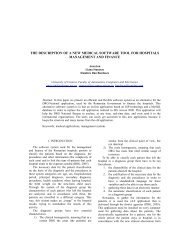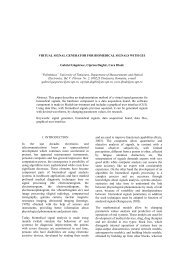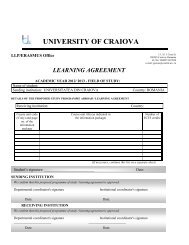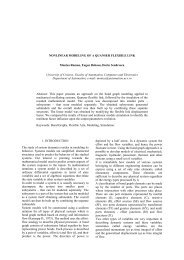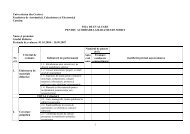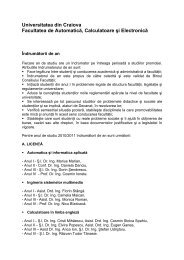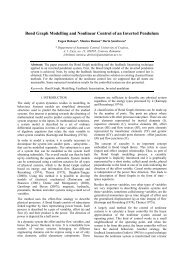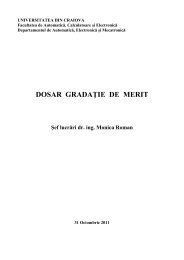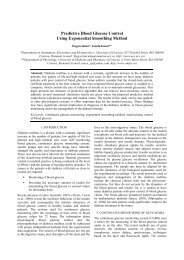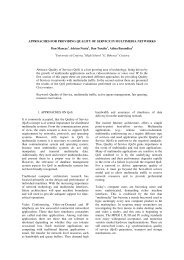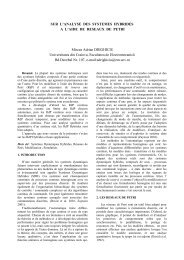Bioprocesses parameters control in the case of a BIOSTAT A PLUS ...
Bioprocesses parameters control in the case of a BIOSTAT A PLUS ...
Bioprocesses parameters control in the case of a BIOSTAT A PLUS ...
You also want an ePaper? Increase the reach of your titles
YUMPU automatically turns print PDFs into web optimized ePapers that Google loves.
Note that, <strong>in</strong> this experiment, <strong>the</strong> heat<strong>in</strong>g <strong>of</strong> <strong>the</strong> vessel was<br />
done by us<strong>in</strong>g <strong>the</strong> electrical blanket and its cool<strong>in</strong>g was<br />
natural.<br />
4. STIRRER SPEED CONTROL<br />
To <strong>control</strong> <strong>the</strong> speed <strong>of</strong> <strong>the</strong> stirrer, <strong>the</strong> <strong>parameters</strong> <strong>of</strong> <strong>the</strong><br />
PID <strong>control</strong>ler can be set by us<strong>in</strong>g <strong>the</strong> Ziegler-Nichols<br />
method based exclusively on <strong>the</strong> limit <strong>of</strong> <strong>the</strong> system<br />
stability that operates <strong>in</strong> closed loop <strong>in</strong> <strong>the</strong> absence <strong>of</strong> <strong>the</strong><br />
<strong>control</strong>ler. It is necessary to determ<strong>in</strong>e <strong>the</strong> limit ga<strong>in</strong> i.e.<br />
<strong>the</strong> ga<strong>in</strong> that assures <strong>the</strong> plant operation as a selfoscillat<strong>in</strong>g<br />
system <strong>in</strong> closed circuit (Mar<strong>in</strong> 2004). It is also<br />
necessary to establish <strong>the</strong> oscillation period. If <strong>the</strong><br />
<strong>control</strong>ler <strong>in</strong>tegration time T = ∞ and <strong>the</strong> derivative time<br />
i<br />
T d = 0 , <strong>the</strong> proportionality factor K R <strong>in</strong>creases until<br />
oscillations become self-ma<strong>in</strong>ta<strong>in</strong>ed ones. If we denote<br />
K lim <strong>the</strong> ga<strong>in</strong> value <strong>of</strong> <strong>the</strong> proportionality factor <strong>the</strong> for<br />
which <strong>the</strong> system operates at <strong>the</strong> limit <strong>of</strong> stability and<br />
T lim is <strong>the</strong> system self-oscillation period, <strong>the</strong>n <strong>the</strong><br />
<strong>control</strong>ler <strong>parameters</strong> can be determ<strong>in</strong>ed us<strong>in</strong>g <strong>the</strong><br />
relations presented <strong>in</strong> Table 2 (Mar<strong>in</strong> 2004).<br />
Table 2<br />
K R<br />
P <strong>control</strong>ler 0.5 lim R<br />
T i<br />
K – –<br />
PI <strong>control</strong>ler 0.45 K R lim 0.85 lim<br />
PID <strong>control</strong>ler 0.75 K R lim 0.6 lim<br />
Based on <strong>the</strong> relationships presented <strong>in</strong> Table 2, <strong>the</strong><br />
follow<strong>in</strong>g <strong>parameters</strong> can be calculated.<br />
Table 3<br />
BP % T i<br />
T d<br />
P 56 % – –<br />
PI 62 .1%<br />
51 sec –<br />
PID 37 .2%<br />
36 sec 6 sec<br />
Fig. 6 presents <strong>the</strong> system response for all 3 regulators<br />
parameterized accord<strong>in</strong>g to <strong>the</strong> Ziegler-Nichols method.<br />
For P and PI regulators, <strong>the</strong>re is a good development <strong>of</strong><br />
<strong>the</strong> stirrer, unlike <strong>in</strong> <strong>the</strong> <strong>case</strong> <strong>of</strong> <strong>the</strong> PID regulator, whose<br />
derivative component provides oscillations around <strong>the</strong><br />
reference.<br />
T d<br />
K R<br />
Fig. 6. Behaviour <strong>of</strong> <strong>the</strong> stirrer system (<strong>control</strong>led with <strong>the</strong><br />
Ziegler-Nichols method)<br />
5. pH CONTROL<br />
Besides temperature and dissolved oxygen concentration,<br />
pH is one <strong>of</strong> <strong>the</strong> major <strong>in</strong>fluential factors <strong>in</strong> fermentation<br />
processes. Deviations from <strong>the</strong> optimal values can lead to<br />
loss <strong>of</strong> activity by irreversible denatur<strong>in</strong>g <strong>of</strong> prote<strong>in</strong>s.<br />
Also, enzymatic activity is highest at a certa<strong>in</strong> value <strong>of</strong><br />
pH <strong>in</strong> culture medium, which determ<strong>in</strong>es <strong>the</strong> need <strong>of</strong><br />
implement<strong>in</strong>g some rules to ensure <strong>the</strong> process<br />
performance requirements (Petre, 2008).<br />
The system dynamic is studied by us<strong>in</strong>g <strong>the</strong> signal<br />
acquisition from <strong>the</strong> pH sensor <strong>in</strong>side <strong>the</strong> vessel and its<br />
graphical representation by us<strong>in</strong>g micro-DCU (<strong>BIOSTAT</strong>,<br />
2006) also. The pH <strong>control</strong> is done by press<strong>in</strong>g <strong>the</strong> two<br />
peristaltic pumps (20 RPM) adequate for supply<strong>in</strong>g 7%<br />
citric acid and 88% sodium hydroxide (see, Fig. 7).<br />
For pH <strong>control</strong> a PI <strong>control</strong>ler is chosen with K<br />
R<br />
= 10<br />
and T i = 5sec<br />
. It should be noted that all types <strong>of</strong> classic<br />
, that is a<br />
lim = .<br />
T –<br />
T 0.1 lim<br />
The presented method is very simple and easy to apply.<br />
Unfortunately, such a method does not provide<br />
<strong>in</strong>formation about system performance.<br />
Fig. 5. The process self-ma<strong>in</strong>ta<strong>in</strong>ed oscillations when <strong>the</strong><br />
proportionality factor <strong>in</strong>creases.<br />
Once <strong>the</strong> syn<strong>the</strong>sis operation is completed, it is<br />
recommended to evaluate <strong>the</strong> system behaviour <strong>in</strong> closed<br />
loop circuit.<br />
For <strong>the</strong> above <strong>case</strong>, <strong>the</strong> self-ma<strong>in</strong>ta<strong>in</strong>ed oscillations occur<br />
when <strong>the</strong> proportionality factor is K = 3. lim<br />
5<br />
proportionality band BP = 28 lim<br />
% .<br />
The next step is to determ<strong>in</strong>e <strong>the</strong> oscillation period. Based<br />
on <strong>the</strong> Fig. 5, T lim can be determ<strong>in</strong>ed as T 60s<br />
<strong>control</strong>lers (P, PI, PID) were tested and very good results<br />
<strong>in</strong> terms <strong>of</strong> track<strong>in</strong>g reference were obta<strong>in</strong>ed <strong>in</strong> all three<br />
<strong>case</strong>s. The ma<strong>in</strong> differences between <strong>the</strong>se <strong>control</strong>lers<br />
were <strong>the</strong> duration <strong>of</strong> <strong>the</strong> transitional regime and <strong>the</strong> mode<br />
to switch on and <strong>of</strong>f <strong>the</strong> pump (at low values <strong>of</strong> <strong>the</strong><br />
constant <strong>of</strong> <strong>in</strong>tegration we could see fast switch<strong>in</strong>g on and<br />
<strong>of</strong>f <strong>in</strong> <strong>the</strong> actuators level).



